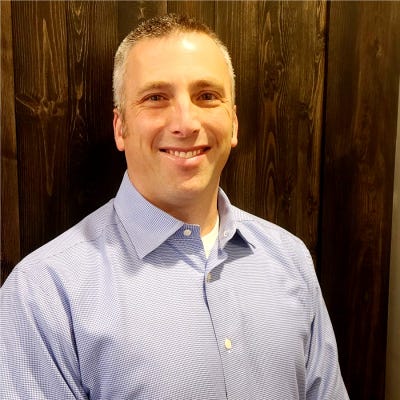What You Can Learn from Three Different AI DeploymentsWhat You Can Learn from Three Different AI Deployments
At the opening keynote for EC AI 2024, three enterprise communications technology professionals shared their perspectives on implementing AI solutions in their organizations.
October 2, 2024

On Tuesday, October 1, the opening keynote at Enterprise Connect AI, featured three executives who provided some insights into what each of their organizations are doing with respect to AI:
Kate Balliet, Head of Experience Design & Growth Strategy with hospitality vendor Aramark, discussed her company’s focus on humanizing AI/human interactions.
Gary LaSasso, Senior Director, Global IT Innovation, with Amicus Therapeutics shared a cautionary tale about getting your data in order before an AI rollout.
Costa Kladianos, Executive Vice President, Head of Technology, San Francisco 49ers, presented a vision of an intelligent stadium that streamlines the fan’s experience with AI and other solutions.
Aramark
Aramark, a multinational hospitality company, operates in 15 countries across many industries (health care, sports and entertainment, etc.). Balliet is focused on helping Aramark delivering “exceptional, differentiated hospitality experiences that help [our customers] reduce friction” across their various functions and/or business processes. With respect to the broad category of AI, Balliet said that Aramark has looked into computer vision-enabled self-checkout to fully autonomous stores and kitchens.
Balliet said that in its college/university segment Aramark is using a conversational AI tool that allows college students can ask questions about their meal plans or figure out how to get a job on campus. “We're really trying to delve into how to make these conversations feel really human, and how to scale them,” she said.
Aramark takes a ‘buy not build’ approach to IT deployments. One of their key learnings has been around finding the right partners. “There are so many players in this space and every story sounds great. You have to learn your way into what really is the best fit and how you can optimize it,” she said.
Balliet said that the overall hospitality industry faces two major headwinds:
It is a single digit margin business that is beholden to changes in costs as well as to ever-shifting trends and preferences.
In the last few years, the sector has lost about 40% of its workforce – and those are people they don’t see necessarily returning to the hospitality sector.
One of her goals is to figure out how to partner AI tools with people, which would address the second major headwind. That collaboration may act as a force multiplier for those who remain in the sector or who enter it. “If we partner people with AI, they can get back to the hospitality delivery that they signed up for,” Balliet said. “So we’re trying to reduce the amount of time they spend behold to a long list of manual tasks – optimizing food and operational costs, predicting cleaning and service schedules etc.”
The 49ers
Kladianos said that his organization, the San Francisco 49ers, is focused around using AI to further improve on their intelligent stadium concept. One of the first things they’re ‘tackling’ is improving the parking experience at the stadium. For example, they’re collaborating with Google to deliver route guidance for fans so that participating fans know when it’s best to leave their homes, what route to take, which gate is best to enter through and where to park. Their overall goal is to make their current ‘pull’ experiences of fans actively seeking the information they want to a ‘push’ experience where the 49ers organization treats everyone like a VIP in terms of knowing their food and beverage preferences, if their kids are with them and who their favorite players are.
“When we have a person at a food and beverage stand doing a manual transaction, it takes an average of four minutes. When it's a frictionless AI-powered experience, it’ll take 30 seconds” Kladianos said. “That allows you to get what you want – and then get back to your seat and enjoy the game with your family and friends.”
But these AI tools – predictive or generative – are just like any other technology project. “You have to look at it as a tool in the toolbox to accomplish a goal, enable strategy and grow the organization.”
Amicus Therapeutics
LaSasso’s organization, Amicus Therapeutics, is a biotech company researching and developing therapies for rare diseases. Currently, they use AI in three areas: productivity, patient-focused (centered around generating revenue), and transformational, meaning that their scientists are using AI to reduce the time it takes to develop those therapies.
With respect to productivity, LaSasso said that as Amicus is a Microsoft customer they have been piloting Copilot for meetings and chats. The company has also integrated a chatbot for Teams through Moveworks, which interacts with ServiceNow and allows employees to raise tickets, make software requests, etc.
“We launched that solution, but [in retrospect] we probably didn't do enough discovery of what our ticket volume and focus areas were. So, people didn’t use it,” LaSasso said. “So, I recommend you make sure that you have solid data – in this case, knowledge base articles – before you launch.”
Now, the solution is being reintroduced with more workflows available, software requests and a ‘transfer to a live agent’ feature, among others, that weren't available in the beginning. LaSasso said further that the Moveworks solution has advanced from the initial launch to now include Gen AI, so there are more opportunities and places for the bot to access data – e.g., from HTML documents on the Intranet, other documents and files, etc.
Final Thoughts: Planning Ahead Is Imperative
All three tech leaders agreed that ironing out AI governance, responsible and ethical AI, as well as clear policies and practices around data security and privacy were key parts of making the deployment successful.
“A couple of years ago, our challenges were around understanding what data you want to put out there what, what's exposed, what get, what becomes public, what becomes training data, and what is private,” Kladianos said. That was largely solved with security policies and documentation. But another step they took was bringing the large language models (LLMs) in house. “With the price of private models coming down, now you can tune models with 11 billion parameters on a couple hundred dollars for the hardware. So you can bring it into a closed circuit in your organization, and it's just as accurate in your niche as the public model would be.”
Balliet said that Aramark’s had success with one year pilot agreements with partners which enables them to fail or succeed quickly and then either expand the relationship or discard. Key considerations include what data is being used, where is it going, how is it going to get there, and is it public or private. “Aramark has taken the stand so far that a lot of the things we've done so far is based on inhouse data.”
LaSasso with Amicus emphasized the need to get data ready for an AI implementation – e.g., by developing a data warehouse – so that it can operate as a single source of truth for the AI. And as a healthcare firm, they have an extra set of global regulations they must abide by. “We have built our governance to the strictest rules and then built back from there.”
About the Author
You May Also Like





